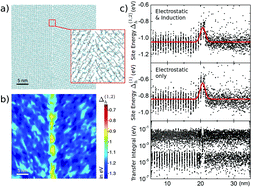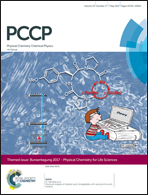Influence of orientation mismatch on charge transport across grain boundaries in tri-isopropylsilylethynyl (TIPS) pentacene thin films†
Abstract
We present a multi-scale model for charge transport across grain boundaries in molecular electronic materials that incorporates packing disorder, electrostatic and polarisation effects. We choose quasi two-dimensional films of tri-isopropylsilylethynyl pentacene (TIPS-P) as a model system representative of technologically relevant crystalline organic semiconductors. We use atomistic molecular dynamics, with a force-field specific for TIPS-P, to generate and equilibrate polycrystalline two-dimensional thin films. The energy landscape is obtained by calculating contributions from electrostatic interactions and polarization. The variation in these contributions leads to energetic barriers between grains. Subsequently, charge transport is simulated using a kinetic Monte-Carlo algorithm. Two-grain systems with varied mutual orientation are studied. We find relatively little effect of long grain boundaries due to the presence of low impedance pathways. However, effects could be more pronounced for systems with limited inter-grain contact areas. Furthermore, we present a lattice model to generalize the model for small molecular systems. In the general case, depending on molecular architecture and packing, grain boundaries can result in interfacial energy barriers, traps or a combination of both with qualitatively different effects on charge transport.

- This article is part of the themed collection: 2017 PCCP HOT Articles


 Please wait while we load your content...
Please wait while we load your content...